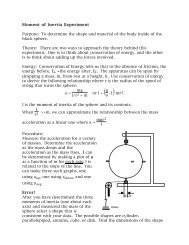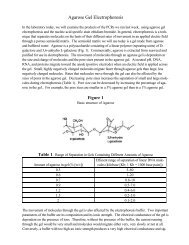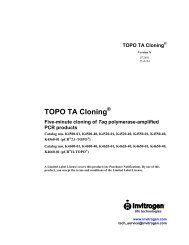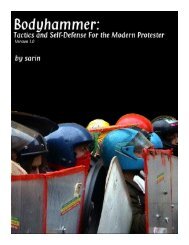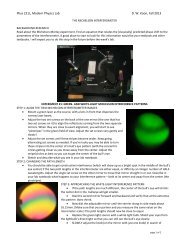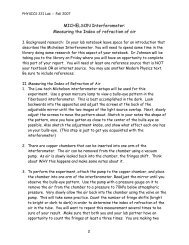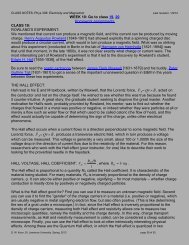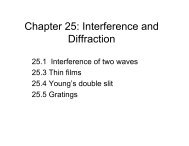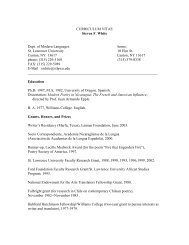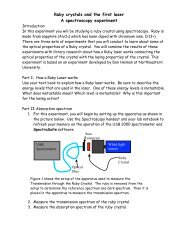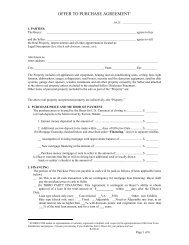Winter, 2005 - St. Lawrence University
Winter, 2005 - St. Lawrence University
Winter, 2005 - St. Lawrence University
- No tags were found...
Create successful ePaper yourself
Turn your PDF publications into a flip-book with our unique Google optimized e-Paper software.
<strong>St</strong>raight from Sean CornellWhat a legacy you have left!Please allow me to introduce myself, my name is Sean Cornell and I am a Ph.D. candidate at the <strong>University</strong>of Cincinnati and Dr. Erickson’s sabbatical replacement for this academic year. Yes he is still here andworking very hard on several projects that I am sure he will talk about himself. Maybe he will decide he canget more work done in retirement? Hint Mark, Hint!A little bit about me: although having lived in the Midwest for the past 6 years, the move in August to Canton has broughtme home so to speak. I was born and raised in the North Country and spent my youth between Chaumont, NY on LakeOntario, and North Bangor, NY on my grandparent’s dairy farm. Canton of course… is half way between so it was astrategic move.I think it is quite remarkable to have this opportunity to come back to northern New York to study some old rocks, and workwith a remarkable set of students! My interests in geology were not with me when I was traipsing around the Adirondacks asa child, and it took me a couple of years at the <strong>University</strong> of Rochester to figure out that my interests in history (NativeAmerican and early American), and wildlife (biology and ecology) might be combined through geology… Hmmm how arethese connected? Well here I am anyway, an echinoderm wannabe paleontologist (Edrioasteroids are cool!), a carbonatesedimentologist, and sequence stratigrapher. Of course, Canton and the Adirondacks are great for all of these things! Well,actually I see Canton as a strategic half-way point here too, half way to my rocks. <strong>St</strong>raddling the Frontenac Arch (almost),SLU sits in a location where the Ordovician-aged carbonates (M.S. and Ph.D. work) are relatively close in both theeast/northeast and westerly directions. For my research, I have been working on a sequence stratigraphic model for theresponse of the carbonate platform to the Taconic Orogeny during the Late Ordovician.Although time is limited for continued field work, (there is a good reason for 4’ of snow – I am trying to finish my dissertation!)I have had the opportunity this fall to get a few days of field work in and participate on some field trips. In SeptemberI co-led 2 field trips to see Ordovician rocks for the New York <strong>St</strong>ate Geological Association hosted by SUNY Oswego, andspent a day showing new colleague Matty <strong>St</strong>rine some of the structural complexities of these Ordovician rocks. Ok, so theyare not “The Snake” or the “Train Wreck” Matty, but they are faulted and dipping some!Other activities this fall: As I am teaching Invert Paleo, and since I studied in Cincinnati, I have upheld the annual pilgrimageto the “Mecca of Paleozoic Paleontology.” On a marathon 4-day trip to Cincinnati, 13 students and myself enjoyed aremarkable trip to study the stratigraphy and paleontology of the Upper Ordovician of northern Kentucky and southwesternOhio. Yes, we also found 7 complete Edrioasteroids, the first to be added to the SLU geology teaching collection! Almost hadone casualty though… A priceless slab of the Cambrian Burgess Shale with a nearly complete specimen of Ottoia (A priapulidworm?) was dropped at the Cincinnati Museum Center Collections Facility by one of our students. No worries though.Thankfully, the slab slammed into the student’s foot, thus breaking the fall. No casualties to the fossil or the student!Also teaching a special topics course on Dinosaurs and spending a great deal of time trying to keep up with the many newdiscoveries in recent years (T. Rex may have had feathers?). This course, led me to the American Museum of Natural Historyin New York City with 11 students where we met up with one of our SLU alums Mr. Glenn Kays ’96. Glenn worked on hisM.S. at North Dakota and now is a Project Hydrogeologist with GSC|Kleinfelder. It was great to meet him and have theopportunity to learn about some of his research interests on fossil turtles.Looking forward to the end of the semester – I am teaching Regional Field <strong>St</strong>udies and will be taking 10 students to Curacaoin January. In addition to RFS and <strong>St</strong>ratigraphy, I will also be offering Ocean Science as well. So of course, I am lookingforward to the end of the semester so I can work diligently on my dissertation and certainly NOT because I am going to theCaribbean before the ice pack sets in!Well, I think I have bantered on long enough so I will close. I do however, want to express my gratitude to the several alumsI met at GSA in Salt Lake City and thank the rest of you for your support of the <strong>St</strong>. <strong>Lawrence</strong> Geology program. Your legacyhas provided an extremely rich and rewarding environment with which I am blessed to be a participant, however abbreviated.Most of all thanks for providing continued opportunities to support the studies and futures of our current students –they are outstanding, and they make my effort so worth it!Paleontology in the News: Discover Magazine has ranked a recent discovery by paleontologists as the number6 th most important science discovery out of 100 this year. The research by Dr. Mary Schweitzer and Dr.Jack Horner, investigated bone microstructure of a T. rex specimen and they have been able torecognize female tissue types! This is the first direct evidence for sexual differentiation in these groups. Ifyou are interested in the original research article, please see: Schweitzer MH, Wittmeyer JL, HornerJR. <strong>2005</strong>. Gender-specific reproductive tissue in ratites and Tyrannosaurus rex. Science 308:1456-1460. Otherwise see the top 100 science stories for <strong>2005</strong> at http://www.discover.com/issues/jan-06/cover/
Michael OwenWe are going to miss you!!!Dear friends,I can’t recall the last time I contributed to the newsletter, but the current edition is my last chance as a member of theGeology Department faculty. After 22 years at <strong>St</strong>. <strong>Lawrence</strong>, I have decided to start a new career. I will be leaving Cantonat the end of this semester, moving to Syracuse to live with my family.I interviewed with Mark Erickson at the GSA annual meeting in New Orleans in the fall of 1982 even though mydissertation was not yet complete. Over stuffed baked potatoes, he described the culture of <strong>St</strong>. <strong>Lawrence</strong>, his vision ofundergraduate geology education, and the then-recent bifurcation of Geology and Geography. I must have said somethingintelligible, because I was invited for an on-campus interview shortly thereafter. The interview itself was mostly a blur, butI do recall the interminable drive back to the Syracuse airport through foot-deep blowing snow in the darkness. Undeterredby the minor inconvenience of a nine-month winter, I joined Mark, Jim <strong>St</strong>reet, and Russ Jacoby in the fall of 1983. WithMark and Jim’s “encouragement,” I completed that darned dissertation promptly.The courses in which I met most geology students were 101/103, 104, Sedimentology, and Sed. Pet. I taught a 100-levelgeology course for more than 35 semesters during my career. By the end, I had discovered PowerPoint so that I no longerhad to rely on my weak artistic ability and arm-waving to illustrate lectures.Remarriage shifted my focus away from Canton because my new wife, Deborah Bradshaw, M.D., has a thriving medicalpractice at Upstate hospital in Syracuse. I commuted on weekends for nearly seven years, a less-than-optimumconfiguration for being a husband and father. This fall, I received an offer of employment, an offer that I couldn’t refuse.Beginning in January, I will be a senior system engineer with Sensis Corp., a firm that designs and builds air traffic controlsystems. The job will involve no geology, but rather my background skills in satellite communications, electronics, andcomputer programming. As Monty Python says, “…and now for something completely different.”The years with students and faculty of the Geology Department have been challenging, satisfying,and above all, fun. It’s an indescribable joy to watch students mature through their four years,becoming self confident and capable adults, whether they end up in geology or not. Having had arole in that development and growth has been a great privilege for which I am sincerely thankful.Leaving the Geology Department would always be difficult, but it especially hard now. I perceivea stronger sense of enthusiastic, healthy purpose among both faculty and students than ever before.Morale is higher, the number of majors is greater, and the sense of joy in learning is morepervasive than at any time I can recall. The combined efforts of the geology faculty and alumniare having a marvelous effect and I am confident that they will continue.Heather Scott Cunningham ‘98’I just wanted to update you on my latest adventure to Tasmania. Work? What is that? I wentwith some friends who are post-doc researchers here. It was nice to get away and Tasmania is awild and beautiful country. And very laid back - most stores closed at 3 on Saturday and did notopen again until Monday. I was suffering from lack of a 24 hr Wal-Mart fix (right!). So among theexciting things I did in Tasmania: hiked Mt Wellington (basalt volcano in the backdrop of Hobart),hiked around Cradle Mt. in the snow, sleet, rain and wind, hiked to Wineglass Bay - one of the mostbeautiful beaches in the world, visited the penal colony of Port Arthur and cruised around some ofthe southern islands. We saw small kangaroos (pantemellons) and wombats and a scorpion whogreeted me in the shower. I am already planning for my next adventure over Christmas. Then Ithink I will have to take it easy after that since I am only on a graduate student budget.School is busy. The graduate students are required to present at a one day seminar that is scheduledfor next Tuesday. In addition to a 15 min. presentation, I have to create a poster. The presentationwas cake but this poster is going to require a few late nights this week for drafting and yellingat the computer and cursing Bill Gates for not making Word Illustrator compatible. I have measuredmy first Nd isotopes using the TIMS. The processes is long and boring but I am told muchshorter and more enjoyable than in the past. I have crushed 27 rocks from the PNG trip I was supposedto go on but the visa fell through on. This week I am hoping to make some XRF pellets andbegin rock digestion for ICP analysis. How scary, I am already sounding like a geochemist!Glacier speed varies,but they generallymove less than threefeet per day. However,in 1936-37, the BlackRapids Glacier inAlaska averaged morethan 100 feet a day —the swiftest everrecorded.http://www.courier-journal.com/foryourinfo/080904/080904.html
Let’s hear from Mark Erickson!!!Greetings to all! Another summer and autumn have marched by but this has been one of thosemost special occasions when I can contemplate their passage without the angst for preparing forclasses! Sabbatical years allow catch up and that is just what I am doing. I taught my musselcourse in June, but only a single student had the fortitude for it. We did make some new discoverieshowever, so it was not time misspent. GSA abstracts went in in mid July and then I tooksome fishing breaks in Vermont with family. Fishing was mixed, but when good it was verygood. A new Vermont state record Muskie (36? lbs) was caught only a stone’s throw from one of my fishing spots – sadly notby me! Late in August, I visited the Heritage Center in Bismarck, ND, where John Hoganson and Bud Holland and I spenttwo weeks together identifying and photographing the fossil fishes of the Fox Hills Fm. which will be the basis for a majormonograph on this important group. Although we are still finding the occasional additional species, I think we have a goodhandle on the fauna after working on the project together since the early 1990,s. Lots of former students will be acknowledgedin that work, you may be certain.Sometime in the summer my paper with John H. came out describing a new ratfish from the Fox Hills named in honor of RayHaas who has helped us in our vertebrate studies for many years. Ray and wife Katherine have put up or fed SLU geologyfield parties on lots of occasions so this was a small repayment of those courtesies. A byrozoan paper with David Waugh andRob Crawford at Kent appeared in the summer also, so those studies are continuing. I have several papers in the works withvarious colleagues and every now and then I have to meet one deadline or another for editing them, but it remains fun to collaboratewith so many researchers.It seemed as though October flew by while I was working on the shark plates so that preparation of my GSA poster almosttook me by surprise and the meeting was early this year. I was one of a group of faculty and students who traveled to SaltLake City for the annual meeting. Senior major Trisha Smrecak presented new results of her two-year investigation of botanicalchange at the K-T boundary in North Dakota. In Summer of 2004, Trisha and I were in the field together; this summerTrisha supported her own research expenses and the Jim <strong>St</strong>reet Fund of the Geology Department assisted with support forMatt Burton-Kelly ’05, as a field assistant in North Dakota. Their GSA poster was visited by most of the paleobotanical expertspresent at the meeting, including Dan Peppe ’03 who is in his 3 rd year of graduate work in Paleobotany at Yale. Two of<strong>St</strong>eve Robinson’s students reported with him on ecotourism in China’s national parks based on their observations during atrip to China last summer. The five students attended talks and visited with graduate schools to learn of programs to whichthey may want to apply. <strong>St</strong>udents made good use of their time, meeting researchers from around the world.Geology faculty, too, had a significant presence at the meeting. Matt <strong>St</strong>rine and Sean Cornell who replace Drs. Shrady andErickson while on sabbatical, presented a research poster and paper respectively. Diane Burns and Dr. Robinson also presentedresearch papers, and Robinson and Dr. Bursnall began the search for Bursnall’s replacement who will follow his retirementin 2006. As part of my sabbatical studies I presented a poster with co-author David Waugh ’99 which was a continuationof research on fossil Bryozoa that they began together as part of Waugh’s BS thesis at <strong>St</strong>. <strong>Lawrence</strong>. That research willcontinue during the sabbatical leave.I was pleased to host a reception for <strong>St</strong>. <strong>Lawrence</strong> alumni held on the first evening of the meeting. Seventeen alumni joinedfaculty, students and friends of the university, including Emeritus Professor of Geography Bill Romey, to share informationand hear news of the department and the university. Dr. Robinson reported on progress of the science complex planning as itaffects the Geology Program. Dr. Barbara Tewksbury, ’74, Kirner Professor of Geology at Hamilton, discussed the qualitiesof the new Geology building at Hamilton which is just now being occupied. It was revealing to hear what institutions likeours are doing. West Coast and Gulf Coast alums like Andrew Fountain, ’76, and Charlie Kerans, ’77, who don’t often get toCanton, enjoyed visits with students who learned about graduate programs and industry directions from these leaders in theirfields. Charlie gave a very interesting presentation at a symposium honoring sedimentologists Bob Ginsburg and Bob Folk.Recent graduate Chris <strong>St</strong>evens presented some of his really interesting GPR data from the MacKenzie Delta in the CanadianArctic and Dan Peppe documented the Paleocene paleomagnetic stratigraphy of western North Dakota. All and all the meetingwas an exceptionally productive one for all <strong>St</strong>. <strong>Lawrence</strong> participants. As you can imagine, I enjoyed it a great deal!Since my return I have worked steadily preparing plates for the shark study I mentioned above. As well I am responsible fora chapter on Oribatid Mite <strong>St</strong>udies for a new Elsevier Series on Quaternary Geology. Booth Platt, a MS student in Roy Norton’slab at SUNY-ESF, is co-authoring this with me and we have an early December due date!Thereafter, I will be working further on the shark paper and on some unionid mussel study. Several projects are waiting inthe wings!
(Let’s hear from Mark Erickson!!! cont.)On the home front, Mother continues to live at Church <strong>St</strong>reet and though she struggles with the stairs she is doing very wellfor her ninety-eight years. I am not very good company but she tolerates me pretty well. Skootie too is doing well and keepsus good company. I hear from Lance once in a blue moon. He sounds like he is enjoying being out on his own. He is stillworking at the home brew supply store in <strong>St</strong>. Paul – they also do a big web business – and still enjoys the thought of openinga brew pub one day. He rarely thinks of graduate study in Geology, but it remains a possibility at least to humor the oldman. I look forward to shooting some pool with him again one of these days.This year we are especially mindful of all of you who have been through the tragic hurricanes of the Gulf Coast and Florida.We have now heard from most but not all who may have been in the path of one or more storms. I know that all who livedin Louisiana were deeply affected and many lost homes and businesses. I hope you can rise from the difficulties with thestrengths that you all showed us so many times at <strong>St</strong>. <strong>Lawrence</strong>. If there is yet anything that we can do, please let us hearfrom you. As the Holidays approach please know that our thoughts are indeed with you.Seasons Greetings from me and from all the SLU Geology Family.GULF COAST ALUMNIThe path of a category 5 hurricane is a sight oneshould never have to see in a lifetime. A numberof you have seen Katrina’s path, however, andwe had great concern for our alums on the GulfCoast. Many, of course, are located in NewOrleans because of industry headquaters.Gradually we have heard from all of you that weknow were in the area, and we know you are safe.That is not to say that you have not sufferedgreat loss; quite the contrary. We know better.If you know of something we can do for youplease let us know. We would love to hear fromyou."Congratulations to CarrieDenesha ‘00’on passing the ASBOGexam and becoming ProfessionalGeologist II !! We always knew youcould do it Carrie.”Jeannine Fiore (Mansfield) ’97’ would like to share.Future GeologistEliasJeannine and Ray have sold there house andmoved to Bloomfield, NY to live nearJeannine’s parents.Their hands will be full with Elias learninghow to crawl and explore. (Must be thegeologist in him).GOOD LUCK IN YOUR NEW HOME!!!Andrew “Dog” Owens ‘99’Working as environmental consultant based in D.C. and Baltimore.I recently married (March, <strong>2005</strong>) to Christin Miller, have a 100+year old farmhouse and forest (very small), a groundhog family thatwe get to watch from our windows.I have recently started investigating the ready-mix concrete andstorm water management industries to expand clients.David Waugh ('99)presents Erickson andWaugh bryozoan poster atGSA Annual Meeting inSalt Lake City.JME photoTrisha Smrecak with theCretaceous "leaf peepers"Dan Peppe '03 and KirkJohnson of the DenverMuseum.JME photo
<strong>St</strong>ephanie Peek in front folded limestone layers outsideof Pinto, MD. <strong>St</strong>ephanie is currently doing a senior thesisproject investigating the kinematics of the BlueRidge Anticlinorium, advised by Matty <strong>St</strong>rine.Hello all.I am at <strong>St</strong>. <strong>Lawrence</strong> for the academic year, replacing Cathy Shrady while she is on sabbatical. I taught <strong>St</strong>ructuralGeology and Introduction to Geological Maps during the Fall semester, and will be teaching Geophysics and Mineralogy inthe Spring. In addition, I am advising a senior thesis project with a field component in the Blue Ridge Anticlinorium.Last year I taught at Bryn Mawr College. This summer I successfully defended my PhD thesis, advised by Gautam Mitraat the <strong>University</strong> of Rochester. For my dissertation, I studied the kinematics of the Moine Thrust zone in NW Scotland.More recently, I have been collaborating with Christian Teyssier and Donna Whitney at the <strong>University</strong> of Minnesotainvestigating the thermal and kinematic evolution of metamorphic core complexes in the North American Cordillera. I amalso collaborating with Sean Cornell (also a faculty in the <strong>St</strong>. <strong>Lawrence</strong> Geology Dept.) on a project to document the mostuseful teaching outcrops within the United <strong>St</strong>ates and assemble a user-friendly, website-database.In October, a slew (no pun intended) of <strong>St</strong>. <strong>Lawrence</strong> faculty and students made our way to Salt Lake City, UT for thenational GSA conference. I presented some data that I collected in SouthMatty <strong>St</strong>rineKorea in collaboration with Dr. Youngdo Park. While some of ourstudents were presenting and/or co-authors, other students came to checkout graduate schools and do some “networking.” I think it was a greatexperience for us all.I hope this newsletter finds you well.Take care,Matty <strong>St</strong>rine (Visiting Assistant Professor)Professor <strong>St</strong>rineand students lookingat some Adirondackdeformation during<strong>St</strong>ructural Geologylab.<strong>St</strong>udents on the <strong>St</strong>ructural Geology field trip to theCatskill Mountains, looking at synorogenic Acadiansediments.
CathyShradyAt the Museum of Natural Historyin NY with SLU Dinosaur class.Hey Glenn that’s not a dinosaur!Greetings to you all and I hope you have a wonderful holiday season! Ihave been enjoying my sabbatical, focusing on writing up the Peruvianresearch I’ve been involved in for the past 5 years or so. I made a trip toPeru in July and plan another trip this March with a student who is doingher senior thesis on a topic related to my interests.In September I was able to attend an environmental justice conference inTalkeetna, Alaska to help prepare for a project I am becoming involvedin looking at contaminants from Formerly Used Defense sites on<strong>St</strong>. <strong>Lawrence</strong> Island, Alaska and their impacts on native communities.This year, two of our students will be applying for summer fellowshipsto work on this project and travel to Alaska with me.In May I will be joining with Mark MacWilliams of the Religious <strong>St</strong>udiesdept. to take a group of 8 students to Kyoto, Japan to study Japanesegardens. The plan is for these students to then help design and build aJapanese garden on the SLU campus and coordinate the use of rock, akey element in Japanese gardens with some of the rocks for the Dolanoutdoor laboratory project. One of our geo. majors is a part of this tripand project and she will be applying for a summer fellowship to researchthe geological materials that will be a part of the campus garden.Not much news to report on the home front. We still own 1 rooster and 7hens (who have stopped laying for the winter, so are entirely useless asfar as I can tell), 2 cats and Petra, the dog. The university has gotten verystrict about dogs in campus buildings these days and we can’t have themin the dept. anymore, a real loss, but what can you do? Teya is 9 andsoon will be up to my shoulder. She continues to enjoy her Appaloosapony, Dottie and contribute to the graying of my hair by now jumping incompetitions.May the new year bring you all health, happiness and peace! Pleasecontinue to keep in touch with us.Hello All,Well, life is certainly full of surprises! Surgery(successful, I might add) in March and general illhealth at that time suggested that I should takemedical leave and retire at the end of that semester.My sincere thanks to Mark for so willingly takingover the chair mid-stream last spring and to Michaelfor agreeing to chair the department on his returnfrom sabbatical this past fall. However, as of threeweeks ago (but somewhat anticipated), I shall be takingover the chair again for the coming spring as well as teaching a combinedpetrology course. I must say, I am truly delighted to be able to dothis (and have to thank Michael for the opportunity)! On the other hand,I am very sorry to see Michael leave us in order to start his new job inSyracuse (check his entry for details). As most of you know, he hasbeen the introducer to geology (through Geol 101 and 103) for virtuallyClose friends all through college and nowthey are moms. We would like tocongratulate Megan Mazzarino ‘97’ on the birth ofher son, and we would like to congratulate <strong>St</strong>efanieHooe ‘97’ on the birth of her son.Future geologists???all of our majors for well over the past decade. Hisefforts have ensured that our enrollments haveremained strong and his enthusiasm for the subject,ability to hold the crowd without losing sight of academicrigor, and genuine care for the students in thesedistribution courses will be a very difficult act to follow.We will miss him, and wish him well in his newventure. However, we just might be looking forwards(hint, hint, Michael!) to using his property in Jamesvilleas a base for some future field trips, if that’s a possibility(one of the largest barns I have ever seen).My newly found ‘free time’ over the past few monthshas allowed me to concentrate on the Dolan OutdoorGeological Laboratory project as well as relocate myoffice in the X-ray lab (and to trash large volumes ofredundant paperwork - FYP papers from the early 90s?Sorry folks - they’re gone!). We are about halfwaythrough the acquisition of samples, but have at leastthree more large installations to collect, and these willbe composite arrays with estimated total weights of 30to 40 tons each, at a rough guess. It’s been a slowprocess but well worth it. The outdoor lab will be awonderful and unique teaching tool when complete –as, indeed, the existing ‘outcrops’ already have been.Our thanks go to Brent LeClerc and Gary Eno ofHanson’s quarry in Jamesville and to Dave Gordon ofGraymont in Potsdam for their enthusiasm and assistance– and for willingly donating about sixty tons oflimestone and sandstone. Thanks are also due to JimGibson for trucking and placement of all of the samplesso far (no more ’45-tonners’, Jim – and I promise not toget lost again!).My thanks, also, go to all of you who donated so muchto the department this past year. You are a very specialgroup. It’s this enthusiastic support and concern for thewell-being of the department that goes such a long wayto make this department stand out and to be so special.Thank you.Happy Holidays and all the very best for the New Year!CheersJohn Bursnall
Pilgrimage to Cincinnati in Invertebrate PaleontologyGeier Collection Center lookingat the Flexicalymene drawer.Front: Emilee Mroz, Chris Nichols Middle: Hillary Siener,Mike Como, Matt Zabik, Brian Congiu, Jessica Klauzenberg,Kate Zubin-<strong>St</strong>athopoulus, Emilia <strong>St</strong>anfill, Sarah FullerBack: Wade Jones, Will Jeffrey, Trisha Smrecak (TA) atMaysville, Kentucky.Kope Formation, Cincinnati, OhioLooking over a juvenileDiplodocus at the CincinnatiMuseum Geier CollectionsCenter. Okay—it’s not aninvertebrate, but we werethere!Isorophus cincinnatiensis. Sharonville, OhioBrian, Chris and Matt show offtheir 15 lb. Olenellid beautyThey are all winnersat our Paleo Pumpkincarving contest!!!Eliza, Wade, Emilee, Sarah,and their 10 lb. HorseshoeCrab, is it Limulus?Emilia, Kate, Jessica and Hillary,showing their seaweed(?) backgroundon their decapod pumpkin.
Geology Club PartyWhen you look quick, itlooks like <strong>St</strong>eve Robinson,but if you look real closeyou will see that it isBrian Congiu.Can anyone tell me who the man is with thewhite beard, or who he’s supposed to be?Brad Barton and Professor <strong>St</strong>rine swap identitiesat the Geology club sponsored department gettogether. Can you tell who is who??GSA <strong>2005</strong>To us in Geology they are Professors’Sean Cornell and <strong>St</strong>eve Robinson, to theoutside world they are professional gokart drivers...or food service experts?The white bison at AntelopeIsland Visitors Center.Is that U2?<strong>St</strong>anding atopPrecambrianquartzites—What a view!Pleistocene-age LakeBonneville TerracesGreat Salt Lake, UT.
Evolving Earth,Vermont Field TripFall, <strong>2005</strong><strong>St</strong>udents hard at work.Claire Plagge and Professor BurnsProfessor OwenProfessor <strong>St</strong>rine and students examining fossilsRob (TA)Professor Owen pointing out a TaconicThrust Faultto a group of students.Professor’s <strong>St</strong>rine andBurns wrapping upone of the outcrops onthe 103 field trip.Chazy fossils anyone!Hey, Rob Menard ‘06’ aren’t you from Chazy?Okay, can anyone tell me what this is???
Well last but certainly not least! I thought I would take a moment to introduce myself. My name is Sherrie Kelly andI am the new departmental office assistant here in Geology. I live in Ogdensburg and have 3 children of my own, 2stepchildren, and 2 grandsons.Although I have been at <strong>St</strong>. <strong>Lawrence</strong> for several years working in the Dean’s Office, I am new to this position. Icurrently wear two hats, one in the Outdoor Program and the other here in Geology. Working in both places keepsme busy, but I feel that the faculty have welcomed me with open arms and have been very helpful in making mytransition..It has been a great semester working in the Geology Department and I have thoroughly enjoyed meeting the studentsand the faculty here – they are certainly an exciting bunch to work with. By the way, did you know that Diane makessome of the best cookies – especially her Lime Meltaways! The Geology Department has offered me a very up-beatand laid-back environment to work in, and the range of challenges given to me makes every day a different one. Ihave especially enjoyed working on this newsletter; it has given me a chance to be creative with design and layout.Moreover I feel it has allowed me the opportunity to learn about the alumni of this program, the wonderfulthings they do, and the amazing places they have traveled and worked. Just imagine what the current students thinkwhen they read about all of your successes– very inspiring!I will say good by now, but please take the time to contact me in the department via phone or email if you have anyquestions or to pass along comments and suggestions regarding this newsletter. I am of course also hoping that youwill send along notice of activities in your life that you would like to contribute to upcoming newsletters, or if youhave any opportunities that you would like passed along to our students.Again, although it has been said many times many ways… Warmest Wishes!



